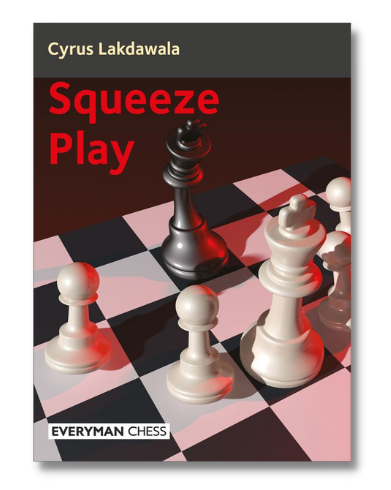When a boa constrictor latches onto its prey, it starts squeezing. Then when the prey exhales, the snake squeezes even tighter until eventually, the battle is won. We can relate this kind of lethal grip to chess, which author Cyrus Lakdawala calls “Squeeze Play“.
The book’s synopsis paints a detailed picture of the squeeze:
“The hero has no advantage whatsoever but somehow manages to keep setting the opponent problems. Their opponent goes slightly astray and suddenly hero has a tiny advantage. It’s not much but now that they have a little something to work with, they are in their element. They play accurately and remorselessly and make life incredibly difficult for their opponent. Suddenly, and almost imperceptibly, their advantage increases. Further tiny inaccuracies follow, hero turns the screw and bags the full point. Their opponent is left shaking their head, wondering where on earth they went wrong.”
Throughout history, we have witnessed great players that have been able to display this kind of squeeze – from Capablanca to Carlsen. They take a seemingly drawn position and pick at it until some kind of advantage, no matter how minor, is created. “Oh well, this will be another draw,” is what the average chess viewer would lament while watching the game, but the grind continues and the opponent is squeezed and squeezed until the advantage increases and eventually becomes a victory.
Such chess is undoubtedly beautiful to see, but confusing all the same! There is little to no chess literature that delves into it, and it would be an injustice to the growth of chess to simply label it as “intuition”. To squeeze one’s opponent requires technique, and in his new chess book Squeeze Play, Cyrus Lakdawala aims to explain the mechanisms behind how the greats were able to squeeze and create something out of nothing.
Squeeze Play : Table of Contents
- Blood from a Stone: How Magnus Squeezes Wins Out of Nothing
- The Squeeze: Exploiting a Territorial Advantage
- Exploiting Weakness on a Single Colour
- Exploiting a Superior Minor Piece
- Initiative and Superior Piece Activity
- Exploiting a Superior Pawn Structure
- Exploiting Imbalances
- Accumulating Advantages
- Converting Extra Material
- Winning From Less than Nothing
A wide range of topics is covered, exploring how to exploit even the smallest weaknesses and advantages
Here is a snippet from the book that elaborates on Carlsen’s system for winning seemingly unwinnable positions:

The author presents many deeply analyzed games of the world’s greatest strategic masters – Capablanca, Petrosian, Karpov, Fischer, Carlsen, and many more. He provides thorough explanations of how the winner managed to keep pushing to score the point, and also presents exercise prompts to the reader such as the following from the chapter Exploiting a Superior Pawn Structure:
Puzzle
E.M Lasker – J Capblanca
Exercise (critical decision):
In this isolani structure, Lasker’s pinned c3-knight is under pressure. White’s choices are:
- Defend the knight with 17.Rc1
- Chop the d5-knight with 17.Bxd5
- Exchange the f6-knight with 17.Bxf6
White stands at least equal, but only if he finds the correct line. Which one do you play?
Let us know what you think in the comments below, and don’t miss out on the book’s special introductory offer at Forward Chess
- The Power of Pattern Recognition: The Woodpecker Method 2 - August 20, 2024
- Rock Solid Chess: Volume 2 - February 21, 2024
- Unsung Heroes of Chess - February 19, 2024

